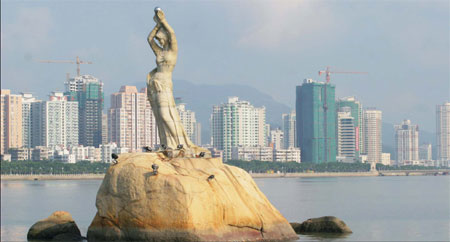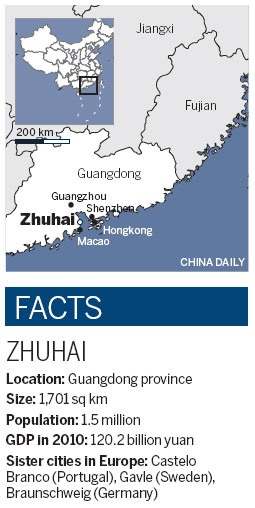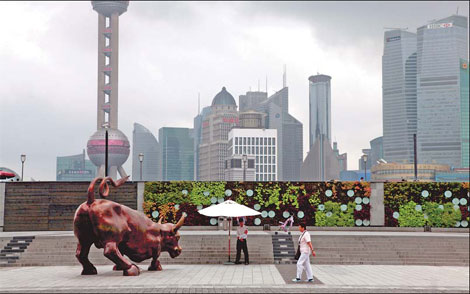"... The urban and rural income growths of 31 Chinese provinces exceeded that of the consumer price index (CPI), a main gauge of inflation, and 29 of these exceeded 10 percent {INCOME GROWTH} in the first half of this year, China Economic Net reported Wednesday. Statistics showed that from January to June, the income growth of rural residents outpaced that of urban residents. Rural residents in 17 provinces witnessed {at least} a 20 percent growth in their income, according to the newspaper. {Billy T comment: little wonder that now in the coastal areas there is a sever labor shortage with Foxconn's salaries up 30% YoY and even with that Foxconn relocated two factories to the interior to get the needed workers.
The US will never have it this good - It is sinking into collapse. Not only is the real purchasing power of the typical Chinese rising several times faster than the rate of inflation, but his "out of pocket" medical costs have been cut in half. (Now pays only1/3 of the cost -state pays 2/3 an exact reverse of two years ago) Thus he is buying more and saving less than the traditional 50% of income. CHINA IS RAPIDLY GROWING THE INTERNAL MARKET. China understands, even if Americans do not, that after the dollar collapse, the US will not be able to buy much of it production.}
Hainan topped the ranking with an urban income growth of 19.4 percent and a rural income growth of 31.7 percent in the first six months this year. Provinces in central and western China saw faster income growth than those in eastern China, the newspaper said. ..."
All income data is stated in Yuan and followed by the one year percentage growth in the first half of the years (2011 vs. 2010).
Location...Urban Income .... Rural Income ......CPI
Beijing......16,236 10.1% ..... 8,732 12.4% ..... 5.5%
Tianjin .....12,861 13.6% ..... 7,337 17.0% ..... 4.3%
Shanghai ..18,382 12.4% ..... 9,369 12.0% ..... 5%
Chongqing .10,383 14.3% .... 3,491 24.1% ..... 5.1%
Liaoning ....10,038 15.4% .... 6,866 22.1% ..... 5.2%
Hebei ....... 9,104.3 11.3% ... 4,195 19.9% ..... 5.3%
Shandong.. 11,098 13.3% .... 5,412 19.3% .... 4.7%
Jiangsu .... 13,741 13.8% ..... 6,421 18.3% .... 5.7%
Zhejiang ...16,835 12.8% ..... 8,439 15.4% ..... 5.4%
Fujian ...... 12,980 12.9% ..... 4,315 18.4% ..... 5.3%
Guangdong 13,903 11.9% .... 5,132 20.3% ..... 5.2%
Hainan ...... 9,512 19.4% ..... 4,188 31.7% ..... 6.6%
Heilongjiang 7,531 11.6% ..... 5,917 22.5% ..... 5.8%
Jilin ....................15.2% ..............24.7% ..... 4.9% (Income in Mongolain money?, not given)
Shanxi.......8,653 14.6% ..... 2,835 20.5% ..... 5%
Henan ......9,009 11.5% ..... 3,177 22.2% ..... 5.8%
Hubei .......9,485 13.6% ..... 3,462 21.6% ..... 5.8%
Hunan ......9,513 12.7% ..... 3,514 21.1% ..... 5.8%
Anhui .......9,356 18.2% ..... 3,584 19.9% ..... 5.7%
Jiangxi .....8,536 12.1% ..... 3,067 21.2% ..... 5.1%
Shaanxi ....9,346 15.6% ..... 3,023 25.3% ..... 5.6%
Gansu ......7,329 13.7% ..... 2,049 27.4% ..... 2.8% Rural income up almost ten times more than inflation! but still < 1/3 of urban income
Ningxia......8,084 12.4% ..... 3,070 17.2% ..... 7.2%
Qinghai .....7,032 8.7% ...... No rural data ..... 8.2% Income up only slightly more than inflation.
Xinjiang ............ 15.9% ............. 24.5% ..... 5.7% (In Mongolia?)
Tibet ...... 1,546 15.2% ..... 1,546 15.2% .. No data
Sichuan ... 9,388 14.9% ..... 3,510 20.1% ..... 6.0%
Guizhou ............ 13% ................ 20% ...... 5.0% (In Mongolia? Or just not yet available?)
Yunnan ... 8,048 12.1% ..... 2,020 12.8% ..... 4.0%
Guangxi ... 9,484 8.8% ...... 3,208 23.1% ..... 6.9% ..."
Above text (except for blue text) and data from: http://usa.chinadaily.com.cn/china/2011-08/03/content_13045027.htm
The US will never have it this good - It is sinking into collapse. Not only is the real purchasing power of the typical Chinese rising several times faster than the rate of inflation, but his "out of pocket" medical costs have been cut in half. (Now pays only1/3 of the cost -state pays 2/3 an exact reverse of two years ago) Thus he is buying more and saving less than the traditional 50% of income. CHINA IS RAPIDLY GROWING THE INTERNAL MARKET. China understands, even if Americans do not, that after the dollar collapse, the US will not be able to buy much of it production.}
Hainan topped the ranking with an urban income growth of 19.4 percent and a rural income growth of 31.7 percent in the first six months this year. Provinces in central and western China saw faster income growth than those in eastern China, the newspaper said. ..."
All income data is stated in Yuan and followed by the one year percentage growth in the first half of the years (2011 vs. 2010).
Location...Urban Income .... Rural Income ......CPI
Beijing......16,236 10.1% ..... 8,732 12.4% ..... 5.5%
Tianjin .....12,861 13.6% ..... 7,337 17.0% ..... 4.3%
Shanghai ..18,382 12.4% ..... 9,369 12.0% ..... 5%
Chongqing .10,383 14.3% .... 3,491 24.1% ..... 5.1%
Liaoning ....10,038 15.4% .... 6,866 22.1% ..... 5.2%
Hebei ....... 9,104.3 11.3% ... 4,195 19.9% ..... 5.3%
Shandong.. 11,098 13.3% .... 5,412 19.3% .... 4.7%
Jiangsu .... 13,741 13.8% ..... 6,421 18.3% .... 5.7%
Zhejiang ...16,835 12.8% ..... 8,439 15.4% ..... 5.4%
Fujian ...... 12,980 12.9% ..... 4,315 18.4% ..... 5.3%
Guangdong 13,903 11.9% .... 5,132 20.3% ..... 5.2%
Hainan ...... 9,512 19.4% ..... 4,188 31.7% ..... 6.6%
Heilongjiang 7,531 11.6% ..... 5,917 22.5% ..... 5.8%
Jilin ....................15.2% ..............24.7% ..... 4.9% (Income in Mongolain money?, not given)
Shanxi.......8,653 14.6% ..... 2,835 20.5% ..... 5%
Henan ......9,009 11.5% ..... 3,177 22.2% ..... 5.8%
Hubei .......9,485 13.6% ..... 3,462 21.6% ..... 5.8%
Hunan ......9,513 12.7% ..... 3,514 21.1% ..... 5.8%
Anhui .......9,356 18.2% ..... 3,584 19.9% ..... 5.7%
Jiangxi .....8,536 12.1% ..... 3,067 21.2% ..... 5.1%
Shaanxi ....9,346 15.6% ..... 3,023 25.3% ..... 5.6%
Gansu ......7,329 13.7% ..... 2,049 27.4% ..... 2.8% Rural income up almost ten times more than inflation! but still < 1/3 of urban income
Ningxia......8,084 12.4% ..... 3,070 17.2% ..... 7.2%
Qinghai .....7,032 8.7% ...... No rural data ..... 8.2% Income up only slightly more than inflation.
Xinjiang ............ 15.9% ............. 24.5% ..... 5.7% (In Mongolia?)
Tibet ...... 1,546 15.2% ..... 1,546 15.2% .. No data
Sichuan ... 9,388 14.9% ..... 3,510 20.1% ..... 6.0%
Guizhou ............ 13% ................ 20% ...... 5.0% (In Mongolia? Or just not yet available?)
Yunnan ... 8,048 12.1% ..... 2,020 12.8% ..... 4.0%
Guangxi ... 9,484 8.8% ...... 3,208 23.1% ..... 6.9% ..."
Above text (except for blue text) and data from: http://usa.chinadaily.com.cn/china/2011-08/03/content_13045027.htm
Last edited by a moderator:





